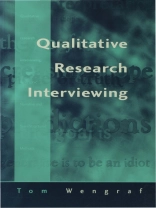`Wengraf provides a comprehensive theoretical and practical guide to the planning, conduct, and interpretative analysis of data by semi-structured interviewing methods. Forthright and frank in his comments about the limitations and practical implications of varying choices which investigators have to make in designing their research projects. Reading this text is like having a tough but expert and caring mentor who wants you to do the best research possible, but will not hesitate to tell you when your ideology and assumptions skew that possibility′ –
Vincent W Hevern, Le Moyne College, USA
Unique in its conceptual coherence and the level of practical detail, this book provides a comprehensive resource for those concerned with the practice of semi-structured interviewing, the most commonly used interview approach in social research, and in particular for in-depth, biographic narrative interviewing. It covers the full range of practices from the identification of topics through to strategies for writing up research findings in diverse ways.
İçerik tablosu
PART ONE: CONCEPTS AND APPROACHES TO DEPTH INTERVIEWING
Interview `Facts′ as Evidence to Support Inferences to Eventual Theorization/Representation Models
Conceptual Frameworks for Studying and Inferring from (Research) Interview Interaction Practice
Models of Research Design and Their Application to Semi-Structured Depth Interviewing
Lightly and Heavily-Structured Depth Interviewing
Theory-Questions and Interviewer-Questions
PART TWO: UP TO THE INERVIEW: STRATEGIES FOR GETTING THE RIGHT MATERIALS
Preparing for Any Interviewing Sequence
Preparing Lightly-Structured Depth Interviews
A Design for a BNIM-Type Biographic-Narrative Interview
Preparing Moderately- or Heavily-Structured Interviews
PART THREE: AROUND THE INTERVIEW: CONTACT MANAGEMENT-THEORY AND PRACTICE
Before Making Contact and Starting the Fieldwork Phase of the Research Process
The Session
PART FOUR: AFTER THE INTERVIEW: STRATEGIES FOR WORKING THE MATERIALS
Copying, Indexing and Transcribing
Analyzing/Interpreting Any Interview Materials
Answers to TQs
Analyzing/Interpreting SQUIN-BNIM Interview Materials
Answers to TQs
PART FIVE: COMPARISON OF CASES: FROM CONTINGENCIES OF CASES TO TYPES OF TYPOLOGIES
Resources for Typification and General-Models within Single-Case Research
Types of Typologies
PART SIX: WRITING UP: STRATEGIES OF RE/PRESENTATION
Conceptual Frameworks for Studying and Re/presenting
Writings Up: Theorizing and Narrating in `Presentation′ Strategies
`Writing Up′ Biographic Sub-Genres
Suggestions by Way of a Conclusion












